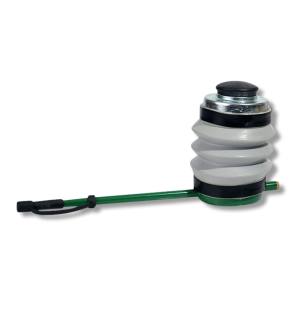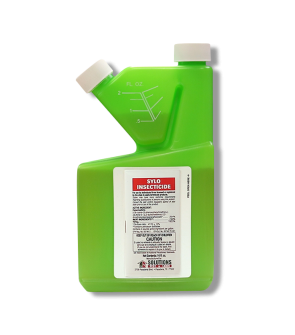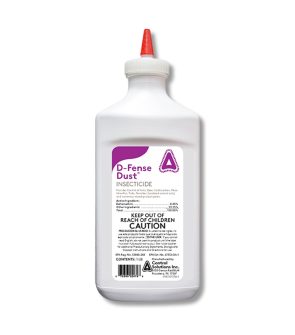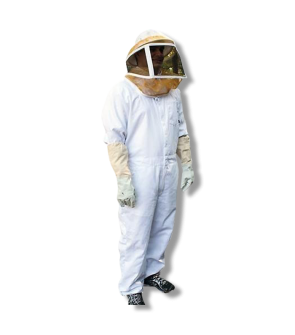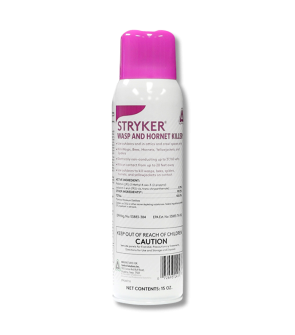Bald-Faced Hornet Control
Most Effective Products
Bald-Faced Hornet Control: How to Get Rid of Bald-Faced Hornets
This article is a general bald-faced hornet control guide. Follow the recommended products and steps listed throughout this easy to use DIY guide, and we guarantee complete control of bald-faced hornets and their nests in your homes yard.
Homeowners throughout the United States are all too familiar with aggressive pests such as bald-faced hornets, especially in the southeastern half. Depending on where you live, this wasp may go by other names such as a white-faced hornet, bald hornet, blackjacket, white-tailed hornet, spruce wasp, or bull hornet. Though it goes by many names this pest is mainly known by homeowners with its ability to be easily agitated and swarm its attacker to sting multiple times.
The bald-faced hornet is actually a type of wasp and relative of the yellow jacket although they are larger. It is because of their large size and aggressive nature they are called hornets, even though they are not true hornets. Like most wasp species, these pests make colonies in the spring with one queen.
Often bald-faced hornets make their nests close to your home or on it making themselves a possible threat to you, your family, and pets. The stinger of the bald-faced hornet is smooth, which means they can inflict a painful sting repeatedly against you or others if they feel you to be a threat. Trying to get rid of bald-faced hornets is difficult for any person, but it can be possible through the recommended products and tips listed throughout this DIY guide.
Identification
Before proceeding with treatment, you will need to be certain the wasp species infesting your yard is a bald-faced hornet. Misidentification can lead you to using the wrong pesticides, which can be a waste of your time and finances. Listed below are some key traits to know what bald-faced hornets look like:

- Unlike other wasp and yellow jacket species, which mainly consist of yellow and black coloring, the bald-faced hornet is mainly black and white. They achieved their name from the white or ivory colored markings that covers most of their face, thorax, and towards the tip of its abdomen with three white stripes while the rest of its body is black. The wings are a translucent dark brown coloration.
- They grow to a larger size than most yellowjackets, with the workers growing up to 15 to 20 mm or longer and the queens size is 3/4".
- Have a long, stout wasp-like body with 6 legs, set of wings, and one pair of antennae.
Use the image and description above to help you in identifying bald-faced hornets. If unsure, then contact us with a photo of your pest through email or in-person at one of our store locations. For your convenience you may also reach out through phone. When you contact us, we can properly identify your pest and recommend an appropriate treatment approach for the pest you are encountering.
Inspection
After properly identifying bald-faced hornets on your property, you can proceed with inspection. During this step, you are determining where bald-faced hornets are found in your yard and conditions attracting them to your home. As aggressive pests, it would be best to wear personal protective equipment (PPE) that keeps you well-covered and fully protected such as a Professional Bee Suit.

Where to Inspect
Bald-faced hornets make their nests at least 3 feet and more off the ground up in tree hollows or branches, shrubs, roof overhangs on sheds or houses, utility poles, underneath eaves or soffits, and against man-made structures like chimneys.
They can be attracted to your home if there is easy access to food, water, and shelter. All of which can be found in your yard, especially if there is sweet liquids, garbage, garden areas with access to insects, and parts of your yard with standing water.
What to Look For
Bald-faced hornet nests are created from a chewed-up wood fibers that become a papery-like material. Unlike hornets, paper wasps, or yellowjackets that have an open cone structure these pests have an enclosed round shaped structure with one single opening towards the bottom of the nest.
These round shaped nests start off small in the spring then becomes larger throughout the summer with a tube extending downward as the colony expands.
As the weather becomes cooler the nests become abandoned, the impregnated queen overwinters in other protected locations such as logs or stumps until spring. When spring arrives the queen awakens to begin a new nest and hunt other insects like caterpillars and others.
Treatment
When dealing with stinging pests like bald-faced hornets, always use caution and keep yourself protected with personal protective equipment (PPE). We recommend you cover up as much exposed skin as possible with a professional bee suit to prevent stings and direct chemical exposure.
To get rid of bald-faced hornets on your property, you will use a combination of insecticides like Stryker Wasp and Hornet Killer, D-Fense Dust, and Sylo Insecticide.
Stryker Wasp and Hornet Killer will knock down bald-faced hornets quickly, D-Fense Dust will treat and kill them as they leave and enter the nest, and Sylo Insecticide will protect the surfaces of your structure from further pest activity.
It would be best to perform these applications in the evening, since bald-faced hornets take shelter inside their nests at night.
Though not specifically mentioned by name, Stryker Wasp and Hornet Killer, D-Fense Dust, and Sylo Insecticide are labeled to kill wasps, which is what a Bald-Faced Hornet is considered.
Step 1: Spray Insecticide Aerosol Spray

Stryker Wasp and Hornet Killer is a 0.1% prallethrin aerosol insecticide that interferes with a wasps central nervous system leading to paralysis then eventual death in one convenient 20 foot spray reach. This safety is further seen with its ability to be electrically non-conductive up to 37,160 volts, meaning you can treat bald-faced hornets harboring around electrical equipment.
Stand from a safe distance of 6-15 ft. from the bald-faced hornet nest, while holding the Stryker Wasp and Hornet Killer upright, but make sure not stand directly underneath.
Align the nozzle valve opening with the mark on the valve cup. Then aim the nozzle valve opening toward the nest with the wind at your back.
Spray the nest until it is thoroughly wet, and contact any escaping wasps so they are killed upon application.
This product may stain or darken asphalt surfaces and shingles. If concerned, test it on a small area that cannot easily be seen.
Step 2: Dust Nest and Exterior Wall Voids

When about 24 hours have passed after application with Stryker Wasp and Hornet Killer, apply D-Fense Dust to treat remaining bald-faced hornets inside the nest or those that did not make contact with the aerosol product. D-Fense Dust is a 0.05% deltamethrin insecticide dust to kill wasps on contact and remains effective by not clumping or absorbing moisture.
D-Fense Dust is intended to be applied with either a hand or power duster to wasp nest, wall voids, and surrounding areas where pests have been seen.
For nests established inside of structures, use a handheld duster to apply D-Fense Dust directly into the void or nest opening.
Be sure to cover the entire perimeter of the opening as you apply the product at the labeled rate of 0.5 lbs. per 1,000 sq. ft. of treatment area. Do not treat overhanging nests.
Pour the appropriate amount of D-Fense Dust to fill halfway inside the Pro Blow Handheld Pesticide Duster. Make sure to not overfill this duster as too much product can cause blockage. Place the cap back onto the duster then turn it upside down and shake to ensure the D-Fense Dust is properly mixed with the air inside the duster.
Thoroughly dust the nest, entrance, and surrounding areas near it. Occasionally, these pests may nest in wall voids so it would be best to insert the extension tube end of the duster into these sites to dust.
Carefully check treated nests when one or two days have passed after application, before removing or destroying the bald-faced hornet nest. If you see pests are still active, then retreat.
Keep this product out of reach of children and pets.
Step 3: Perform Barrier Treatment

After you have treated the nests around your property, you will make a barrier treatment with Sylo Insecticide to prevent any bald-faced hornets from reinfesting your structures.
Spray a 0.1% emulsion of Sylo. You can do this easily by mixing half an ounce of Sylo with one gallon of water. We recommend you use a handheld pump sprayer since you will be spraying around the perimeter of your structure.
Once your solution is mixed, apply Sylo around the exterior of your home and other structures. Treat along spots where bald-faced hornets would build nests like along eaves, underneath porch ceilings, and around voids into structures. This will leave a residual application that will help prevent wasps from re-establishing nests for up to 90 days.
Prevention
Once bald-faced hornets have been eliminated from your yard, you will need to carry out preventative measures to ensure these pests do not return. Follow these recommended preventative procedures to prevent and repel bald-faced hornets from your home and yard:

- Make sure that trash cans have tight-fitted lids and stored far away from your homes foundation. This eliminates a possible food source for bald-faced hornets, or any other hornet or other pests.
- Caulk the cracks and crevice around your home and other man-made structures on your property to prevent them from becoming a nesting site. Tight cracks should be sealed with caulk, while wider voids and crevices can be stuffed with Copper Mesh.
- Trim back any overhanging tree branches and overgrown shrubs around your home and structure as bald-faced hornets prefer dense vegetation for nests.
- Lastly, be sure to keep up with regular reapplications of Sylo Insecticide. When applied properly, Sylo Insecticide will prevent reinfestation of treated areas up to 90 days after application. We recommend you apply Sylo Insecticide on a quarterly basis for year-round control. Spray along eaves and entry points like around door and window frames. Then, perform a barrier treatment by spraying along your homes outer perimeter by going 3 feet up and 6 to 10 feet out. When application is complete, keep people and pets away from treated areas until completely dry.
Key Takeaways
What are Bald-Faced Hornets?
- Despite their name, bald-faced hornets are not true hornets, but rather a type of wasp species that closely associates them with yellowjackets. With their aggressive nature and high population rate in colonies make these pests less than ideal for any homeowners property.
How to Get Rid of Bald-Faced Hornets
- To get rid of bald-faced hornets use Stryker Wasp and Hornet Killer to directly kill pests on contact then treat nests with D-Fense Dust to treat any remaining pests in the nests or that did not come into contact with the aerosol insecticide spray.
Preventing Bald-Faced Hornet Reinfestation
- Prevent bald-faced hornets from returning to your home and plants by making a barrier application with Sylo Insecticide every 3 months and on-going pruning of dense vegetation within your yard.

